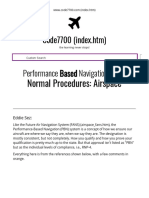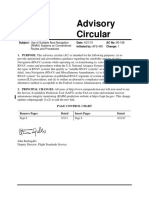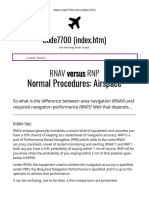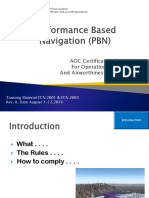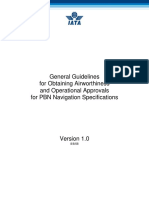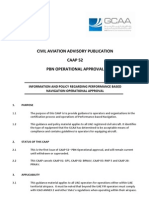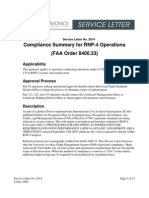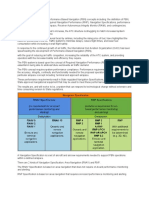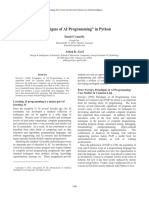Web - AC 90-100A RC Compliance Matrix PDF
Web - AC 90-100A RC Compliance Matrix PDF
Uploaded by
Ruben FigueroaCopyright:
Available Formats
Web - AC 90-100A RC Compliance Matrix PDF
Web - AC 90-100A RC Compliance Matrix PDF
Uploaded by
Ruben FigueroaOriginal Title
Copyright
Available Formats
Share this document
Did you find this document useful?
Is this content inappropriate?
Copyright:
Available Formats
Web - AC 90-100A RC Compliance Matrix PDF
Web - AC 90-100A RC Compliance Matrix PDF
Uploaded by
Ruben FigueroaCopyright:
Available Formats
AC 90-100A Compliance for Rockwell Collins FMS-3000, FMS-4200, FMS/AMS-5000, FMS-6000, and FMS-6100
Source Para Requirement Compliant? Applicability Notes and Comments
1. Purpose N/A N/A Title Line
1.a Purpose a. This advisory circular (AC) provides operational and N/A N/A Explanatory text
airworthiness guidance for operation on U.S. Area Navigation
(RNAV) routes, Instrument Departure Procedures (DPs), and
Standard Terminal Arrivals (STARs). Operators and pilots
should use the guidance in this AC to determine their eligibility
for these U.S. RNAV routes and procedures. In lieu of following
this guidance without deviation, operators may elect to follow an
alternative method, provided the alternative method is found to
be acceptable by the Federal Aviation Administration (FAA). For
the purpose of this AC, “compliance” means meeting operational
and functional performance criteria. Mandatory terms in this AC
such as “must” are used only to ensure applicability of these
particular methods of compliance when the acceptable means of
compliance described are used. This AC does not change, add,
or delete regulatory requirements or authorize deviations from
regulatory requirements.
1.a Purpose NOTE: New applicants for a type certificate (TC) or (S)TC Applicant To be addressed by new applicants for a type
supplemental type certificate (STC) should include a statement certificate (TC) or supplemental type certificate
of compliance to this AC and qualification for U.S. RNAV routes (STC)
and terminal procedures when the aircraft is found in compliance
with this AC.
1.b Applicability of b. Applicability of AC 90-100A. AC 90-100A applies to N/A N/A Explanatory text
AC 90-100A operation on U.S. Area Navigation (RNAV) routes (Q-routes and
T-routes), Departure Procedures (Obstacle Departure
Procedures and Standard Instrument Departures), and Standard
Terminal Arrivals (STARs). It does not apply to over water RNAV
routes (ref 14 CFR 91.511, including the Q-routes in the Gulf of
Mexico and the Atlantic routes) or Alaska VOR/DME RNAV
routes ("JxxxR"). It does not apply to off-route RNAV operations,
Alaska GPS routes or Caribbean routes, or helicopter operations
involving offshore or specific heliport procedures.
1.c Performance- This AC sets out a series of performance and functional criteria N/A N/A Explanatory text
based navigation necessary to conduct RNAV procedures. Aircraft compliant with
concept AC 90-45A, Approval of Area Navigation Systems for Use in the
U.S. National Airspace System, may not be compliant with
criteria contained herein.
1.d Background d. Background. This criterion is consistent with the ICAO N/A N/A Explanatory text
guidance material for the implementation of area navigation
(RNAV 1 and RNAV 2) operations. AC 90-100 became effective
7 January 2005. Since then, ICAO has continued to harmonize
area navigation
(RNAV) performance criteria. AC 90-100A reflects these
harmonized ICAO performance-based navigation criteria as well
as lessons learned from the initial US RNAV implementation.
Thursday, December 06, 2007 Page 1 of 14
Source Para Requirement Compliant? Applicability Notes and Comments
1.e Structure e. Structure. After the initial paragraphs which include N/A N/A Explanatory text
Terminology and References, this AC is structured as follows:
o General Information (paragraph 6)
o RNAV System Eligibility (paragraph 7)
o RNAV System Approval Process (paragraph 8)
o Operator Approval Process (paragraph 9)
o Flight Crew Operating Procedures (paragraph 10)
o Pilot Knowledge Requirements and Training (paragraph 11)
o Criteria for RNAV Systems Using DME (Appendix 1)
o Criteria for RNAV Systems Using DME and Inertial (Appendix
2)
o Criteria for RNAV System Functionality (Appendix 3)
2.0 Cancellation CANCELLATION. Advisory Circular 90-100, U.S. Terminal and (S)TC Applicant New applicants for a type certificate (TC) or
En Route Area Navigation (RNAV) Operations, dated January 7, supplemental type certificate (STC) must
2005, is canceled. cancel any previous AFM statements
regarding cancelled AC 90-100.
3.0 RELATED Title 14 of the Code of Federal Regulations (14 CFR), Part 91, N/A N/A Explanatory text
CODE OF sections 91.123 and 91.205; Part 95; Part 121, section 121.349;
FEDERAL Part 125, section 125.203; Part 129, section 129.17; and Part
REGULATIONS 135, section 135.165.
SECTIONS.
4.TERMINOLOGY For the purpose of operations on RNAV routes and procedures, N/A N/A Title Line
. the following definitions are provided:
4.a Aircraft-Based a. Aircraft-Based Augmentation System (ABAS). A system N/A N/A Explanatory text
Augmentation augmenting and/or integrating information obtained from other
System (ABAS) GNSS elements with information on board the aircraft. The most
common form of ABAS is receiver autonomous integrity
monitoring (RAIM).
4.b Area A method of navigation which permits aircraft operation on any N/A N/A Explanatory text
Navigation desired flight path within the coverage of station-referenced
(RNAV). navigation aids or within the limits of the capability of self-
contained aids, or a combination of these. For the purposes of
this AC, the specified RNAV accuracy must be met 95% of the
flight time.
4.b(1) RNAV 1 b(1) RNAV 1 requires a total system error of not more than 1 N/A N/A Explanatory text
NM for 95% of the total flight time.
4.b(2) RNAV 2 b(1) RNAV 2 requires a total system error of not more than 2 N/A N/A Explanatory text
NM for 95% of the total flight time.
4.c. Area a. Area Navigation (RNAV) System. This AC only addresses N/A N/A Explanatory text
Navigation RNAV systems using positioning inputs from GPS/GNSS and
(RNAV) System. DME, and IRU. Criteria for RNAV systems are discussed in
appendix 1 and 2. Criteria for RNAV system functionality is
discussed in appendix 3.
Thursday, December 06, 2007 Page 2 of 14
Source Para Requirement Compliant? Applicability Notes and Comments
4.d Critical DME a. Critical DME. A DME facility that, when unavailable, results N/A N/A Explanatory text
in navigation service which is insufficient for DME/DME/IRU
supported operations along a specific route or procedure. The
required performance assumes an aircraft’s RNAV system meets
the minimum standard (baseline) for DME/DME RNAV systems
found in appendix 1, or the minimum standard for DME/DME/IRU
systems found in appendix 2. For example, terminal RNAV DPs
and STARs may be published with only two DMEs, in which
case, both are critical.
4.e DME/DME e. DME/DME (D/D) RNAV refers to navigation using DME N/A N/A Explanatory text
(D/D) RNAV ranging from at least two DME facilities to determine position.
4.f f. DME/DME/Inertial (D/D/I) RNAV refers to navigation using N/A N/A Explanatory text
DME/DME/Inertial DME ranging from at least two DME facilities to determine
(D/D/I) position along with use of an inertial reference unit (IRU) to
provide sufficient position information during limited DME gaps.
4.g Flight g. Flight Technical Error (FTE). Accuracy with which an aircraft N/A N/A Explanatory text
Technical Error is controlled, as measured by the indicated aircraft position with
(FTE) respect to the indicated command or desired position. It does
not include procedural blunder errors.
4.h Global h. Global Navigation Satellite System (GNSS). The GNSS is a N/A N/A Explanatory text
Navigation worldwide position and time determination system, which
Satellite System includes one or more satellite constellations, aircraft receivers,
(GNSS) and system integrity monitoring. GNSS is augmented as
necessary to support the required navigation performance for the
actual phase of operation.
4.i Global i. Global Positioning System (GPS). The U.S. GNSS core N/A N/A Explanatory text
Positioning satellite constellation providing space-based positioning, velocity,
System (GPS) and time. GPS is composed of space, control, and user
elements.
4.j Position j. Position estimation error (PEE). Difference between true N/A N/A Explanatory text
estimation error position and estimated position.
(PEE)
4.k Receiver k. Receiver Autonomous Integrity Monitoring (RAIM). A N/A N/A Explanatory text
Autonomous technique used within a GPS receiver/processor to monitor GPS
Integrity signal performance. This integrity determination is achieved by a
Monitoring (RAIM) consistency check among redundant measurements.
4.l RNAV l. RNAV Procedure. An RNAV Instrument Departure Procedure N/A N/A Explanatory text
Procedure or RNAV Standard Terminal Arrival.
4.l(1) Instrument l (1) Instrument Departure Procedure. A DP is a published IFR N/A N/A Explanatory text
Departure procedure providing obstruction clearance from the terminal area
Procedure to the en route structure. There are two types of DPs: Standard
Instrument Departures (SIDs) and Obstacle Departure
Procedures (ODPs).
Thursday, December 06, 2007 Page 3 of 14
Source Para Requirement Compliant? Applicability Notes and Comments
4.l(1)(i) 4.l(1)(i) Standard Instrument Departure (SID). A SID is a N/A N/A Explanatory text
Instrument published IFR air traffic control (ATC) departure procedure
Departure providing obstacle clearance and a transition from the terminal
Procedure area to the en route structure. SIDs are primarily designed for air
traffic system enhancement to expedite traffic flow and to reduce
pilot/controller workload.
4.l(1)(ii) Obstacle 4.l(1)(ii) Obstacle Departure Procedure (ODP). A preplanned N/A N/A Explanatory text
Departure instrument flight rule (IFR) departure procedure printed for pilot
Procedure (ODP). use in textual or graphic form to provide obstruction clearance via
the least onerous route from the terminal area to the appropriate
en route structure. ODPs are recommended for obstruction
clearance and may be flown without ATC clearance unless an
alternate departure procedure (SID or radar vector) has been
specifically assigned by ATC.
4.l(2) Standard 4.l(2) Standard Terminal Arrival (STAR). A STAR is a published N/A N/A Explanatory text
Terminal Arrival IFR air traffic control arrival procedure that provides a transition
(STAR) from the en route structure to the terminal area. STARs may
include one or more runway transitions providing guidance to
either a standard instrument approach procedure or a point in
space from which radar vectors are provided by ATC.
4.m RNAV Route m. RNAV Route. An RNAV route (“Q” or “T”), within the high or N/A N/A Explanatory text
low altitude structure of the Contiguous United States, requiring
system performance by GPS/GNSS or DME/DME/IRU RNAV
systems, as required.
4.n. Total System n. Total System Error. The difference between the true position N/A N/A Explanatory text
Error and the desired position. This error is equal to the vector sum of
the path steering error, path definition error, and position
estimation error.
5. References (NOTE: All references to the edition are current as of the N/A N/A Explanatory text
publication date of this AC).
6. General General Information on RNAV 1 and RNAV 2 Operations N/A N/A Title line
Information on
RNAV 1 and
RNAV 2
Operations
6.a Operation on 6.a Operation on U.S. RNAV routes, DPs, and STARs: Operator
U.S. RNAV
routes, DPs, and
STARs:
6.a(1) a(1) Relies on normal descent profiles and identifies minimum N/A N/A
segment altitude requirements;
6.a(1) Note NOTE: Pilots operating aircraft with an approved Baro-VNAV Operator
system may continue to use their Baro-VNAV system while
executing U.S. RNAV routes, DPs, and STARs. Operators must
ensure compliance with all altitude constraints as published in
the procedure by reference to the barometric altimeter.
Thursday, December 06, 2007 Page 4 of 14
Source Para Requirement Compliant? Applicability Notes and Comments
6.a(2) a(2) Does not require the pilot to monitor ground-based NAVAIDs Operator According to the AFM, POH, or operating
used in position updating unless required by the Airplane Flight manual, as applicable
Manual (AFM), Pilot Operating Handbook (POH), or the
operating manual for their avionics;
6.a(3) a(3) Bases obstacle clearance assessments on the associated N/A N/A
required system performance; and
6.a(4) a(4) Guidance in this AC does not supersede appropriate New (S)TC applicant
operating requirements for equipage. For example, Part 91 can and Operator
have a single RNAV system, and Part 121 can have a single
RNAV system and another independent navigation system
allowing safe flight to a suitable alternate airport.
6.b b. The DME navigation infrastructure supporting the design of an N/A N/A
RNAV route or procedure has been assessed and validated by
the FAA. This includes analysis by FAA flight inspection assets.
DME coverage may use Expanded Service Volume (ESV) for
select DME facilities so there is no requirement to use VOR,
LOC, NDB, or AHRS during normal operation of the DME/DME
RNAV system. ESV facilities require a satisfactory flight
inspection prior to use.
6.b(1) b(1) DME signals are considered to meet signal-in-space N/A N/A Assumption
accuracy tolerances everywhere the signals are received.
6.b(2) b(2) For RNAV operations where reliance is placed upon the Installed equipment, Applicable only to installations with
IRU, some aircraft systems temporarily revert to VOR/DME- new (S)TC DME/DME/IRU. In FMS 3.3.1 and later
based navigation before reverting to inertial coasting. When the applicant, and versions, the FMS annunciates "CHK POS" in
VOR is within 40 NM from the route/procedure and there is operator yellow on the PFD and "VOR/DME DIST
insufficient DME/DME navigation infrastructure, the impact of >40.0NM" in yellow on the CDU when
VOR radial accuracy has been evaluated by the FAA and navigation is based solely on a VOR/DME that
determined to not affect aircraft position accuracy. is greater than 40.0NM from the aircraft
position. The AFM or POH, as applicable,
should contain a statement prohibiting AC 90-
100A RNAV operations when this condition
exists.
6.b(3) b(3) The available navigation infrastructure supporting the Operator It is the operator's responsibility to only
procedure will be clearly designated on all appropriate charts (for operator on routes for which the installed
example, GPS or DME/DME/IRU). equipment is capable and authorized. FMS
versions prior to FMS 3.3.1 are not capable of
AC 90-100A operations with DME/DME/IRU.
6.b(4) (4) The FAA will monitor the navigation infrastructure and issue Operator It is the operator's responsibility to operate in
timely warnings of outages (NOTAM). accordance with NOTAMs.
6.b(5) b(5) The navigation standard (for example, RNAV 1 or RNAV 2) Operator It is the operator's reponsibility to operate in
required for all RNAV procedures/routes will be clearly accordance with RNAV 1 procedures on SIDs,
designated on all appropriate charts. However, SIDs, ODPs, and ODPS, and STARs.
STARs will be flown with RNAV 1 procedures.
Thursday, December 06, 2007 Page 5 of 14
Source Para Requirement Compliant? Applicability Notes and Comments
6.b(6) b(6) All routes and procedures referenced in this AC are Operator It is the operator's responsibility to only
intended to be flown by DME/DME/IRU and/or GPS/GNSS operator on routes for which the installed
equipped aircraft meeting the performance requirements in this equipment is capable and authorized. FMS
AC. versions prior to FMS 3.3.1 are not capable of
AC 90-100A operations with DME/DME/IRU.
6.c 6.c If any critical DME facilities exist, they are identified within the Operator Applicable to FMS 3.3.1 and later versions
relevant U.S. Flight Information Publications (FLIP). when operations are based on DME/DME/IRU
navigation. The operator should be aware
that the availability of critical DMEs (NOTAM
conditions) will impact the ability of the FMS to
perform DME/DME/IRU navigation. As
separately indentified herein, the FMS
annunciates when navigation does not meet
the requirements of AC 90-100A, including
"IRS ONLY", or "CHK POS" with "VOR/DME
DIST >40.0nm", or "FMS DR" when no
position fixing sensors are available.
6.d 6.d Unless the RNAV route, DP, or STAR specifically requires Operator
GPS or GNSS equipage, aircraft on the RNAV route, DP, or
STAR must be within ATC radar surveillance and communication.
6.e 6.e. All DME ground stations maintained by the FAA and used N/A N/A
to define the availability of these RNAV routes, DPs, and STARs
comply with applicable ICAO standards.
6.f 6.f. All routes/procedures must be based upon WGS 84 N/A N/A
coordinates.
6.g g. The navigation data published for the routes, procedures and N/A N/A
supporting navigation aids must meet the requirements of ICAO
Annex 15.
7.0 RNAV N/A N/A Title Line
System Eligibility
7.a a. Aircraft with a statement of compliance to this AC in their New (S)TC applicant
Aircraft Flight Manual (AFM), Pilot Operating Handbook (POH), or operator
or the operating manual for their avionics meet the performance
and functional requirements of this AC.
7.b b. Aircraft with P-RNAV approval based on GNSS capability According to AFM, New (S)TC applicant All FMS-3000, FMS-4200, FMS/AMS-5000,
meet the functional requirements of this AC. Due to differences POH, or operating or operator FMS-6000, and FMS-6100 meet the JAA TGL-
in radio navigation infrastructure in the United States, if the manual, as 10 and FAA AC 90-96A equipment
approval is based on DME/DME or DME/DME/IRU, the operator applicable. requirement for P-RNAV based on GNSS
should ensure the equipment meets the criteria in appendix 1 or capability, provided there is no installed,
2, as applicable. intermixed equipment that is incompatible with
the intermixed equipment requirements in JAA
TGL-10 or FAA AC 20-138a.
7.c c. The following systems meet many of the requirements As stated below As stated below
defined in this AC. Such equipment still requires evaluation by
the manufacturer against all the functional and performance
requirements in this AC.
Thursday, December 06, 2007 Page 6 of 14
Source Para Requirement Compliant? Applicability Notes and Comments
7.c (continued) The RAIM prediction program should comply with the criteria in Yes RAIM Prediction Options are 1) Collins RAIM Prediction
AC 20-138A, paragraph 12. program program CPN 832-3443-008 or later, 2) FAA
en route and terminal RAIM prediction
website: www.raimprediction.net , 3) by
contacting a Flight Service Station.
7.c(1) c(1) Aircraft with TSO-C129/C129a sensor (Class B or C) and Yes, if GPS-4000 Installed equipment
the requirements in a TSO-C115b FMS, installed for IFR use or GPS-4000A is
IAW AC 20-130A. installed for IFR
use IAW AC 20-
130A.
7.c(2) c(2) Aircraft with TSO-C145a sensor, and the requirements in a Yes, if GPS-4000S Installation
TSO-C115b FMS, installed for IFR use IAW AC 20-130A or AC is installed for IFR
20-138A. use IAW AC 20-
130A.
7.c(3) c(3) Aircraft with TSO-C129/C129a Class A1 (without deviating N/A N/A Class A1 does not apply to subject
from the functionality described in Appendix 3 of this document) installations.
installed for IFR use IAW AC 20-138 or AC 20-138A.
7.c(4) c(4) Aircraft with TSO-C146a (without deviating from the N/A N/A
functionality described in Appendix 3 of this document) installed
for IFR use IAW AC 20-138A.
7.c Note NOTE: Refer to paragraph 5 for TSO and AC references. N/A N/A
7.d d. Aircraft with a statement from the manufacturer documenting OEM, (S)TC
compliance with the criteria in this AC (appendix 1 or 2, as applicant, or
applicable, and appendix 3) meet the performance and functional Operator
requirements of this AC. These statements should include the
airworthiness basis for compliance. Compliance with the sensor
requirements in paragraph 8 will have to be determined by the
equipment or aircraft manufacturer, while compliance with the
functional requirements in Appendix 3 may be determined by the
manufacturer or by inspection by the operator.
7.d Note 1 NOTE 1: Aircraft with a demonstrated RNP capability will N/A N/A
annunciate when no longer satisfying the performance
requirement associated with the operation. However, for
DME/DME/IRU-based procedures, the manufacturer still has to
determine compliance with appendix 1 or 2 to support evaluation
of the DME infrastructure.
Thursday, December 06, 2007 Page 7 of 14
Source Para Requirement Compliant? Applicability Notes and Comments
7.d Note 2 NOTE 2: Aircraft with a TSO-C129 GPS sensor and a TSO- See comments OEM or (S)TC FMS-3000, FMS-4200, FMS/AMS-5000, FMS-
C115 or C115a FMS may not meet all of the requirements applicant 6000, and FMS-6100 are capable when
defined in this AC. Such equipment would require further installed with GPS-4000() and approved for
evaluation by the manufacturer against all the functional and IFR use in accordance with AC 20-130A. The
performance requirements in this AC. FMS must be receiving useable GNSS
signals. Aircraft must be operated in
accordance with AC 90-100A, including use of
flight director and/or autopilot. Operator must
confirm validity Type 2 LOA for the navigation
database for the intended operations.
Reference:
http://www.rockwellcollins.com/fms/navalerts.a
sp
8. RNAV System RNAV System Approval Process N/A N/A
Approval Process
8.a a. Navigation System Accuracy. The navigation system N/A N/A Explanatory text
accuracy is dependent on the total system error, defined in
paragraph 4 of this AC.
8.a(1) a(1) RNAV Routes: Aircraft operating on RNAV routes must OEM, (S)TC The installation is capable for FMS-3000, FMS-
maintain a total system error bounded by the RNAV value for applicant, Operator 4200, FMS/AMS-5000, FMS-6000, and FMS-
95% of the total flight time. A flight technical error (FTE) of 1.0 6100 equipment when installed with GPS-
NM (95%) is acceptable for RNAV 2 operations. RNAV 2 will be 4000() and approved for IFR use in
used for en route unless otherwise specified. accordance with AC 20-130A. The FMS must
be receiving useable GNSS signals. Aircraft
must be operated in accordance with AC 90-
100A, including use of flight director and/or
autopilot. Note: FMS 3.3.1 and later versions
meet the equiment requirements [of Appendix
2] for DME/DME/IRU, but the capability for
DME/DME/IRU navigation has not yet been
demonstrated.
8.a(2) a(2) RNAV 1 DPs and STARs. Aircraft operating on RNAV 1 OEM, (S)TC The installation is capable for FMS-3000, FMS-
DPs and STARs must maintain a total system error of not more applicant, Operator 4200, FMS/AMS-5000, FMS-6000, and FMS-
than 1 NM for 95% of the total flight time. An FTE of 0.5 NM 6100 equipment when installed with GPS-
(95%) is acceptable for RNAV 1 operations. RNAV 1 will appear 4000() and approved for IFR use in
on all RNAV SID and STAR charts. accordance with AC 20-130A. The FMS must
be receiving useable GNSS signals. Aircraft
must be operated in accordance with AC 90-
100A, including use of flight director and/or
autopilot. Note: FMS 3.3.1 and later versions
meet the equiment requirements [of Appendix
2] for DME/DME/IRU, but the capability for
DME/DME/IRU navigation has not yet been
demonstrated.
8.b b. Navigation Sensors. U.S. RNAV operations are based upon As stated in As stated in
the use of RNAV equipment that automatically determines following following subsections
aircraft position in the horizontal plane using inputs from the subsections
following types of positioning sensors (no specific priority).
Thursday, December 06, 2007 Page 8 of 14
Source Para Requirement Compliant? Applicability Notes and Comments
8.b(1) b(1) Global Navigation Satellite System (GNSS) in accordance See comments Installed equipment The installation is capable for FMS-3000, FMS-
with TSO-C145a, TSO-C146a, and TSO-C129/C129a. 4200, FMS/AMS-5000, FMS-6000, and FMS-
Positioning data from other types of navigation sensors may be 6100 equipment when installed with GPS-
integrated with the GNSS data provided it does not cause 4000() and approved for IFR use in
position errors exceeding the total system error requirements. accordance with AC 20-130A. The FMS must
The use of GPS equipment approved to TSO-C129() is limited to be receiving useable GNSS signals.
those which include the minimum system functions specified in
Appendix 3. As a minimum, integrity should be provided by
ABAS. In addition, GPS stand-alone equipment should include
the following additional functions:
o Pseudorange step detection
o Health word checking.
8.b(1) (continued) b(1) (continued) For procedures requiring GPS and/or aircraft See comments Operator The operator must recognize indications that
approvals requiring GPS, if the navigation system does not either the FMS is not navigating with GPS or
automatically alert the flight crew of a loss of GPS, the operator GPS operations are not authorized. The FMS
must develop procedures to verify correct GPS operation. automatically alerts the crew, including the
following CDU messages: "GPS NOT
AVAILABLE", "NO GPS RAIM", "GPS-FMS
DISAGREE". Messages displayed on the
PFD, in addition to the "MSG" for a new CDU
message, include "IRS ONLY", "FMS DR",
and "CHK POS". FMS 3.3.1 and later
versions also display "V/D ONLY" or "CHK
POS" on the PFD with "VOR/DME DIST
>40.0NM" on the CDU, as appropriate.
8.b(2) DME/DME RNAV equipment complying with the criteria in N/A N/A
appendix 1. Based on current DME availability evaluations,
coverage is not sufficient to support DME/DME RNAV operations
without additional IRU augmentation or using GPS.
8.b(3) DME/DME/IRU RNAV equipment complying with the criteria in See comments Installed equipment Applicable only to FMS 3.3.1 and later
appendix 2. versions when installed as multi-sensor with
DME and IRU equipment interfaces to the
FMS. Note: FMS 3.3.1 and later versions
meet the equipment requirements [of
Appendix 2] for DME/DME/IRU, but the
capability for DME/DME/IRU navigation has
not yet been demonstrated at the aircraft
system level.
8.b Note NOTE: LORAN-C criteria have not been developed. N/A N/A
8.c Functional criteria listed in Appendix 3. The requirements of Compliance is as detailed for Appendix 3
Appendix 3 help ensure aircraft RNAV system performance
meets procedure design criteria.
9.0 Operator Operator Approval Process Operator The operator must address compliance with
Approval Process this section.
10.0 U.S. RNAV U.S. RNAV Flight Crew Operation Procedures Operator The operator must address compliance with
Flight Crew this section.
Operation
Procedures
Thursday, December 06, 2007 Page 9 of 14
Source Para Requirement Compliant? Applicability Notes and Comments
11.0 Pilot Pilot Knowledge Requirements and Training Operator The operator must address compliance with
Knowledge this section.
Requirements
and Training
Appendix 1 Appendix 1. Criteria for Approval of Baseline Area Navigation Installed equipment Applicable on the FMS 3.3.1 and later
(RNAV) Systems Using Distance Measuring Equipment (DME) versions when installed as multisensor with
DME equipment interfaces to the FMS in
accordance with AC 20-130A.
Appendix 2 Appendix 2. Criteria for Approval of Baseline Area Navigation Installed equipment Applicable on the FMS 3.3.1 and later
(RNAV) Systems Using Distance Measuring Equipment (DME) veresions when installed as multisensor with
and Inertial Reference Unit DME and IRU equipment interfaces to the
FMS in accordance with AC 20-130A.
Appendix 3 Appendix 3. Navigation Displays and Functions As detailed in the Installed Equipment
following
subsections
Appendix 3, 1. Navigation data, including a to/from indication and a failure Yes Installed Equipment
indicator, must be displayed on a lateral deviation display such
as CDI, (E)HSI and/or a navigation map display. These shall be
used as primary flight instruments for the navigation of the
aircraft, for maneuver anticipation and for failure/status/integrity
indication. They shall meet the following requirements:
Appendix 3, 1.a 1.a Non-numeric lateral deviation display (for example, CDI, Yes Installed Equipment
(E)HSI), with a To/From indication and a failure annunciation, for
use as primary flight instruments for navigation of the aircraft, for
maneuver anticipation, and for failure/status/integrity indication,
with the following five attributes:
Appendix 3, 1.a(1) 1.a(1) The displays shall be visible to the pilot and located in the See comments Installed Equipment Yes, provided the equipment is installed in
primary field of view (± 15 degrees from pilot’s normal line of accordance with AC 20-130A
sight) when looking forward along the flight path.
Appendix 3, 1.a(2) 1.a(2)The lateral deviation scaling should agree with any alerting See comments Installed Equipment Yes. The FMS-3000, FMS-4200, FMS/AMS-
and annunciation limits, if implemented. 5000, FMS-6000, and FMS-6100, perform the
normal function of stand-alone GNSS
equipment when in stalled with GPS-4000().
Terminal Lateral Deviation scaling and GNSS
Horizontal Alert Limit is 1nm within 30nm of
the origin or destination airport. En route
Lateral Deviation scaling is 5nm with a GNSS
Horizontal Alert Limit of 2nm. FMS 3.3.1 and
later versions have appropriate annunciations
related to DME/DME/IRU navigation as
detailed herein for other items.
Appendix 3, 1.a(3) 1.a(3) The lateral deviation display must also have a full-scale See comments Installed Equipment Yes, as detailed Appendix 3, item 1.a(2)
deflection suitable for the current phase of flight and must be
based on the required total system accuracy.
Thursday, December 06, 2007 Page 10 of 14
Source Para Requirement Compliant? Applicability Notes and Comments
Appendix 3, 1.a(4) 1.a(4) The display scaling may be set automatically by default See comments Installed Equipment Yes, as detailed Appendix 3, item 1.a(2)
logic or set to a value obtained from a navigation database. The
full-scale deflection value must be known or must be available for
display to the pilot commensurate with en route or terminal
values.
Appendix 3, 1.a(5) (5) The lateral deviation display must be automatically slaved to Yes Installed Equipment
the RNAV computed path. The course selector to the deviation
display should be automatically slewed to the RNAV computed
path or the pilot must adjust the OBS or HSI selected course to
the computed desired track.
Appendix 3, 1.a NOTE: The normal function of stand-alone GNSS equipment N/A Installed Equipment When installed with GPS-4000(), the FMS-
Note meets this requirement. 3000, FMS-4200, FMS/AMS-5000, FMS-6000,
and FMS-6100 perform the normal function of
stand-alone GNSS equipment detailed for
other items in Appendix 3.
Appendix 3, 1.b 1.b If using a navigation map display, it should give equivalent See comments Installed Equipment The CDI/HSI is used for navigation, not the
functionality to a lateral deviation display as described above, FMS map display. The map display is readily
(Appendix 3, paragraph 1.a. (1-5)), readily visible to the pilot, with visible to the pilot and has appropriate scales
appropriate map scales (scaling may be set manually by the which may be set manually by the pilot.
pilot).
Appendix 3, 2. 2. The following system functions are required as a minimum As detailed in the Installed Equipment
within RNAV equipment: following
subsections
Appendix 3, 2.a a. The capability to continuously display to the pilot flying, on Yes Installed Equipment
the primary flight instruments for navigation of the aircraft
(primary navigation display), the RNAV computed desired path
and aircraft position relative to the path.
Appendix 3, 2.b b. For operations where the required flight crew is two pilots, Yes Installed Equipment
means for both pilots to verify the desired path and the aircraft
position relative to the path.
Appendix 3, 2.c c. A navigation database, containing current navigation data See comments Operator and The equipment complies when a current
officially promulgated for civil aviation, which can be updated in Installed equipment navigation database is loaded for which a
accordance with the Aeronautical Information Regulation and Type 2 LOA is valid. It is the operator's
Control (AIRAC) cycle and from which terminal airspace responsibility that the loaded navigation
procedures can be retrieved and loaded into the RNAV system. database be current and that the Type 2 LOA
The stored resolution of the data must be sufficient to achieve for the navigation database be valid for the
the required total system error. The database must be protected U.S. RNAV routes and/or procedures. Refer
against pilot modification of the stored data. to
http://www.rockwellcollins.com/fms/navalerts.a
sp regarding Type 2 LOA for navigation
databases delivered by Rockwell Collins, Inc.
Appendix 3, 2.d The means to display the validity period of the navigation data to Yes Installed equipment
the pilot.
Appendix 3, 3. 3. The means to retrieve and display data stored in the Yes Installed equipment
navigation database relating to individual waypoints and
navigation aids, to enable the pilot to verify the route/procedure
to be flown.
Thursday, December 06, 2007 Page 11 of 14
Source Para Requirement Compliant? Applicability Notes and Comments
Appendix 3, 4. 4. The entire RNAV segment of the DP or STAR to be flown See comments Operator and The FMS-3000, FMS-4200, FMS/AMS-5000,
must be extracted from the navigation database. In this Installed equipment FMS-6000, and FMS-6100 extracts the entire
document, the RNAV segment begins at the first occurrence of a RNAV segment from the navigation database,
named waypoint, track, or course and ends at the last as coded in the navigation database, including
occurrence of a named waypoint, track, or course. Heading legs, any heading or direct-to legs coded in the
prior to the first named waypoint or after the last named waypoint navigation database. It is the operators
of a procedure, are not part of the RNAV segment and do not responsibility to operate the FMS using the
have to be loaded from the database. Similarly, direct-to-fix legs data extracted from the navigation database.
prior to the first named waypoint of a procedure are not part of
the RNAV segment. While not required, the ability to extract the
entire RNAV procedure, including heading and direct-to-fix legs,
from the database is a recommended function.
Appendix 3, 5. 5. The means to display the following items, either in the pilot’s As detailed in the Installed equipment
primary field of view, or on a readily accessible page on a multi- following
function control display unit (MCDU). subsections
Appendix 3, 5.a 5.a The active navigation sensor type Yes Installed equipment
Appendix 3, 5.b 5.b The identification of the active (To) waypoint Yes Installed equipment
Appendix 3, 5.c 5.c The ground speed or time to the active (To) waypoint Yes Installed equipment
Appendix 3, 5.d 5.d The distance and bearing to the active (To) waypoint Yes Installed equipment
Appendix 3, 6 6. Where the MCDU is used to support accuracy checks by the Yes Installed equipment The CDU PROGRESS page 2/2 displays
pilot, the capability of displaying lateral deviation with a resolution numeric lateral deviation with a resolution of
of at least 0.1 NM. 0.01 NM.
Appendix 3, 7 7. The capability for the navigation system to execute a “Direct Yes Installed equipment
to” function.
Appendix 3, 8 8. The capability for automatic leg sequencing with display of Yes Installed equipment LEGS page 1 displayes the toggle selection
sequencing to the pilot. SEQUENCE AUTO/INHIB. The FMS
annunciates SEQ INHB on the PFD when
sequencing is inhibited other than for a
discontinuity.
Appendix 3, 9 9. The capability to execute procedures extracted from the Yes Installed equipment
onboard database including the capability to execute fly-over and
fly-by turns.
Appendix 3, 10 10. The capability to execute leg transitions and maintain tracks As detailed in the Installed equipment
consistent with the following ARINC 424 path terminators: following
subsectiosn
Appendix 3, 10a 10.a. The aircraft must have the capability to automatically Yes Installed equipment
execute leg transitions and maintain tracks consistent with the
following ARINC 424 path terminators, or their equivalent:
• Initial Fix (IF)
• Course to Fix (CF)
• Direct to Fix (DF)
• Track to Fix (TF)
Thursday, December 06, 2007 Page 12 of 14
Source Para Requirement Compliant? Applicability Notes and Comments
Appendix 3, 10a NOTE 1: Path terminators are defined in ARINC Specification N/A N/A Explanatory text
Note 1 424, and their application is described in more detail in RTCA
documents DO 236B and DO-201A.
Appendix 3, 10a NOTE 2: Numeric values for courses and tracks must be Yes Installed equipment Full CF leg capability from the navigation
Note 2 automatically loaded from the RNAV system database. database is provided.
However, automatic CF capability is not required for approval to
fly: (1) all RNAV routes covered by this AC as these are
constructed using TF path terminators, or (2) those ODPs using
a DF or TF path terminator for the first segment.
Appendix 3, 10b 10.b. The aircraft must have the capability to automatically Yes Installed equipment Full VA, VM, and VI capability from the
execute leg transitions consistent with VA, VM and VI ARINC navigation database is provided.
424 path terminators, or must be able to be manually flown on a
heading to intercept a course or to go direct to another fix after
reaching a procedure-specified altitude.
Appendix 3, 10c 10.c The aircraft must have the capability to automatically Yes Installed equipment Full CA and FM capaiblity from the navigation
execute leg transitions consistent with CA and FM ARINC 424 database is provided.
path terminators or the RNAV system must permit the pilot to
readily designate a waypoint and select a desired course to or
from a designated waypoint.
Appendix 3, 11 11. The capability to load a named RNAV route into an RNAV Yes Installed equipment Full route capability from the navigation
system from the database is a recommended function. database is provided. If instead the pilot uses
However, if all or part of the RNAV route (not DP or STAR) is manual entry of fixes from the navigation
entered through the manual entry of fixes from the navigation databse, the FMS defaults to the TF leg type
database, a TF leg type must be used to define the path between to define the path, as described for this item.
a manually entered by name fix and the preceding and following
fixes.
Appendix 3, 12 12. The capability to display an indication of the RNAV system Yes Installed equipment Refer to AFM, POH, operators manual, or
failure, including the associated sensors, in the pilot’s primary FMS Pilots Guide, as appropriate.
field of view.
Appendix 3, 13 For multi-sensor systems, capability for automatic reversion to See comments Installed equipment Yes, for systems installed as multi-sensor with
an alternate RNAV sensor if the primary RNAV sensor fails. DME and/or IRU.
NOTE: This does not preclude providing a means for manual
navigation source selection.
Appendix 3, 14 15. Database Integrity. The navigation database should be See comments Rockwell Collins, Inc Type 2 LOA validity for the current navigation
obtained from a database supplier holding an FAA Letter of database as delivered by Rockwell Collins,
Acceptance (LOA) in accordance with AC 20-153. This LOA Inc, is available at
provides recognition of a data supplier’s compliance with the http://www.rockwellcollins.com/fms/navalerts.a
data quality, integrity and quality management practices of RTCA sp
DO-200A, Standards for Processing Aeronautical Data. The
operator’s supplier (e.g., FMS manufacturer) must have a Type 2
LOA.
Thursday, December 06, 2007 Page 13 of 14
Source Para Requirement Compliant? Applicability Notes and Comments
Appendix 3, 14 Discrepancies that invalidate a procedure must be reported to Operator
(continued) the database supplier and affected procedures must be
prohibited by an operator’s notice to its flight crew. Aircraft
operators should consider the need to conduct ongoing checks
of the operational navigation databases in order to meet existing
quality system requirements.
NOTE: AC 20-153 contains procedures for database LOAs.
Appendix 3, 15 15. It is recommended RNAV systems provide lateral guidance See comments Operator, installed The installed equipment performs as
so aircraft remain within the lateral boundaries of the fly-by equipment, airframe recommended within the operational and
transition area as defined in DO-236B, section 3.2.5.4.1. aerodynamics, and design limitations. Operational conditions,
environmental such as selecting HALF BANK or TURB
conditions autopilot modes, impact the ability of the
installed equipment to comply. Operational
and environmental conditions, such as
airspeeds and wind resulting in high grounds
speeds, also impact the ability to comply.
Thursday, December 06, 2007 Page 14 of 14
You might also like
- 737 Performance Reference Handbook - EASA EditionFrom Everand737 Performance Reference Handbook - EASA EditionRating: 4.5 out of 5 stars4.5/5 (3)
- Commercial Pilot Oral Exam Guide: The comprehensive guide to prepare you for the FAA checkrideFrom EverandCommercial Pilot Oral Exam Guide: The comprehensive guide to prepare you for the FAA checkrideRating: 3 out of 5 stars3/5 (2)
- PBN Manual - ICAO Doc 9613 Final 5.10.08Document294 pagesPBN Manual - ICAO Doc 9613 Final 5.10.08Liviu Per100% (4)
- Matlab Simulink TutorialDocument94 pagesMatlab Simulink TutorialGAUTAM DUA0% (1)
- RNP NotesDocument40 pagesRNP Notesskynorth50% (2)
- ATPLViva QuestionsDocument27 pagesATPLViva QuestionscaptravipooniaNo ratings yet
- AC 90-100A RC Compliance Matrix PDFDocument14 pagesAC 90-100A RC Compliance Matrix PDFArun SasiNo ratings yet
- Understanding Required Navigation Performance (RNP) and Area Navigation (RNAV) OperationsDocument8 pagesUnderstanding Required Navigation Performance (RNP) and Area Navigation (RNAV) OperationsPablo Di GregorioNo ratings yet
- 5pbn Ac 91-003 Rnav1-Rnav2 EngDocument40 pages5pbn Ac 91-003 Rnav1-Rnav2 EngAbdel Hafid Lahreche100% (1)
- Understanding Required Navigation Performance (RNP) and Area Navigation (RNAV) OperationsDocument8 pagesUnderstanding Required Navigation Performance (RNP) and Area Navigation (RNAV) OperationsaleNo ratings yet
- Normal Procedures: Airspace: Code7700 (Index - HTM)Document7 pagesNormal Procedures: Airspace: Code7700 (Index - HTM)Pero PericNo ratings yet
- Advisory Circular: Subject: Aircraft and Operators Approval For RNP Approach (RNP Apch) OperationsDocument26 pagesAdvisory Circular: Subject: Aircraft and Operators Approval For RNP Approach (RNP Apch) OperationsJaime PinedaNo ratings yet
- CAA-AC-GEN021A PBN Approval General InformationDocument5 pagesCAA-AC-GEN021A PBN Approval General InformationLinias MtimbaNo ratings yet
- Advisory Circular: Subject: Approval Guidance For RNP Date: 2/23/11 Initiated By: AFS-400 AC No: 90-101A ChangeDocument43 pagesAdvisory Circular: Subject: Approval Guidance For RNP Date: 2/23/11 Initiated By: AFS-400 AC No: 90-101A Changenunov_144376No ratings yet
- RNP AR Compatibility Trace MatrixDocument39 pagesRNP AR Compatibility Trace MatrixvinayNo ratings yet
- Ac90-105 RNPDocument39 pagesAc90-105 RNPMarko Ivankovic100% (1)
- Advisory Circular: Subject: Use of Suitable Area Navigation Date: 4/21/15 AC No: 90-108 Initiated By: AFS-400 Change: 1Document11 pagesAdvisory Circular: Subject: Use of Suitable Area Navigation Date: 4/21/15 AC No: 90-108 Initiated By: AFS-400 Change: 1rdpereirNo ratings yet
- Airspace RNAV Vs RNPDocument14 pagesAirspace RNAV Vs RNPPero PericNo ratings yet
- Ac 90-96a CHG 1Document27 pagesAc 90-96a CHG 1sandraNo ratings yet
- P RNAV DefinitionDocument24 pagesP RNAV DefinitionVito Gentile100% (2)
- Performance Based Navigation (PBN)Document40 pagesPerformance Based Navigation (PBN)Bayu Chandra100% (4)
- 8260 55Document12 pages8260 55JAIRONo ratings yet
- RNP Vs Rnav Vs RNP RnavDocument8 pagesRNP Vs Rnav Vs RNP Rnavtarun86100% (1)
- Aeronautical Charting Forum Instrument Procedures Group: October 27, 2009Document6 pagesAeronautical Charting Forum Instrument Procedures Group: October 27, 2009sandro5avantaggiatoNo ratings yet
- Rnav & RNP - Kfa NotesDocument29 pagesRnav & RNP - Kfa NotesPrashant Verma100% (1)
- Rnav Vs RNPDocument11 pagesRnav Vs RNPchamarousios123No ratings yet
- Application Form - Compliance For PRNAV (RNAV 1) ApprovalDocument45 pagesApplication Form - Compliance For PRNAV (RNAV 1) ApprovalBtrs BtrstNo ratings yet
- RCAA-AC-PANSOPS003 Guidance On Implementation of Performance Based Navigation PBN in RwandaDocument29 pagesRCAA-AC-PANSOPS003 Guidance On Implementation of Performance Based Navigation PBN in RwandaSMS Mien BăcNo ratings yet
- General: Precision RNAV (P-RNAV) P-RNAV Is The AircraftDocument1 pageGeneral: Precision RNAV (P-RNAV) P-RNAV Is The AircraftDIPNo ratings yet
- Tac-033 Ac RNPDocument26 pagesTac-033 Ac RNPJSUROBOYONo ratings yet
- IATA Guidelines For PBN Operational ApprovalDocument28 pagesIATA Guidelines For PBN Operational Approvalmsm100% (1)
- GCAA CAAP 52 October UpdateDocument67 pagesGCAA CAAP 52 October UpdateJazon AlvesNo ratings yet
- RNP APCHDocument13 pagesRNP APCHshammi tapseNo ratings yet
- Why P RNAVDocument2 pagesWhy P RNAVravnanyNo ratings yet
- Operations Circular: Subject: Aircraft and Operators Approval For RNP 1 OperationsDocument39 pagesOperations Circular: Subject: Aircraft and Operators Approval For RNP 1 Operationsmehul da aviatorNo ratings yet
- Advisory Circular: Subject: Approval Guidance For RNP Date: 2/9/16 AC No: 90-101A Initiated By: AFS-400 Change: 1Document51 pagesAdvisory Circular: Subject: Approval Guidance For RNP Date: 2/9/16 AC No: 90-101A Initiated By: AFS-400 Change: 1sigit sutokoNo ratings yet
- Faa B-RnavDocument10 pagesFaa B-RnavMikeNo ratings yet
- Ac 32-Area Navigation - Rnav 2 & 1Document5 pagesAc 32-Area Navigation - Rnav 2 & 1KINGDOEMSELYNo ratings yet
- Operations Circular: OC NO 11 OF 2014 Date: 04 SEPT. 2014Document36 pagesOperations Circular: OC NO 11 OF 2014 Date: 04 SEPT. 2014mehul da aviatorNo ratings yet
- ALPR06 OTAC 39 17 91 12 121-17 125-15 135 17 PBN Approvals Issue2Document13 pagesALPR06 OTAC 39 17 91 12 121-17 125-15 135 17 PBN Approvals Issue2Tariq khosoNo ratings yet
- Jaa TGL-10 (Rnav) PDFDocument29 pagesJaa TGL-10 (Rnav) PDFtangautaNo ratings yet
- AC 91 11 Aircraft ADS B Equipment StandardsDocument23 pagesAC 91 11 Aircraft ADS B Equipment StandardssahandonfireNo ratings yet
- Civil Aviation Requirement Section 2 - Airworthiness Series 'O', Part Xii Issue Ii, 22 AUGUST 2008 Effective: ForthwithDocument41 pagesCivil Aviation Requirement Section 2 - Airworthiness Series 'O', Part Xii Issue Ii, 22 AUGUST 2008 Effective: Forthwithmehul da aviatorNo ratings yet
- RNP-4 Operations Sl2814Document13 pagesRNP-4 Operations Sl2814Ö Tahir ÖzgenNo ratings yet
- Operations Circular 05 of 2018: Government of India Civil Aviation Department Director General of Civil AviationDocument8 pagesOperations Circular 05 of 2018: Government of India Civil Aviation Department Director General of Civil Aviationmehul da aviatorNo ratings yet
- PBNDocument8 pagesPBNKedamawi RecordsNo ratings yet
- Advisory Circular: AC 91U-II-C-2Document10 pagesAdvisory Circular: AC 91U-II-C-2Le ThangNo ratings yet
- Amc 20-4aDocument6 pagesAmc 20-4aandrewNo ratings yet
- Civil Aviation Requirement Section 2 - Airworthiness Series 'O', Part Xii Issue Ii, 22 AUGUST 2008 Effective: ForthwithDocument41 pagesCivil Aviation Requirement Section 2 - Airworthiness Series 'O', Part Xii Issue Ii, 22 AUGUST 2008 Effective: ForthwithvishwaaskNo ratings yet
- Advisory Circular: U.S. Department of TransportationDocument19 pagesAdvisory Circular: U.S. Department of TransportationrdpereirNo ratings yet
- AIC China RVSM 2007102473541105Document66 pagesAIC China RVSM 2007102473541105juanNo ratings yet
- TGL No 10 Rev. 1Document27 pagesTGL No 10 Rev. 1Nick ArdacNo ratings yet
- Reduced Vertical Separation Minimum (RVSM) ApprovalsDocument33 pagesReduced Vertical Separation Minimum (RVSM) Approvalsbrady100% (1)
- Aircraft Dispatcher Practical Test Standards (2025): FAA-S-8081-10EFrom EverandAircraft Dispatcher Practical Test Standards (2025): FAA-S-8081-10ENo ratings yet
- Airman Certification Standards: Remote Pilot - Small Unmanned Aircraft Systems (2025): FAA-S-ACS-10BFrom EverandAirman Certification Standards: Remote Pilot - Small Unmanned Aircraft Systems (2025): FAA-S-ACS-10BNo ratings yet
- Airline Transport Pilot Oral Exam Guide: Comprehensive preparation for the FAA checkrideFrom EverandAirline Transport Pilot Oral Exam Guide: Comprehensive preparation for the FAA checkrideNo ratings yet
- Remote Pilot Airman Certification Standards: FAA-S-ACS-10A, for Unmanned Aircraft SystemsFrom EverandRemote Pilot Airman Certification Standards: FAA-S-ACS-10A, for Unmanned Aircraft SystemsNo ratings yet
- Airman Certification Standards: Airline Transport Pilot and Type Rating - Airplane (2025): FAA-S-ACS-11AFrom EverandAirman Certification Standards: Airline Transport Pilot and Type Rating - Airplane (2025): FAA-S-ACS-11ANo ratings yet
- Flight Instructor Instrument Practical Test Standards for Airplane & Helicopter (2025): FAA-S-8081-9EFrom EverandFlight Instructor Instrument Practical Test Standards for Airplane & Helicopter (2025): FAA-S-8081-9ENo ratings yet
- Airman Certification Standards: Commercial Pilot - Airplane (2025): FAA-S-ACS-7BFrom EverandAirman Certification Standards: Commercial Pilot - Airplane (2025): FAA-S-ACS-7BNo ratings yet
- Instrument Procedures Handbook (2025): FAA-H-8083-16BFrom EverandInstrument Procedures Handbook (2025): FAA-H-8083-16BRating: 4 out of 5 stars4/5 (7)
- Airbus A320 Primary Flight Controls - DutchOps - Com PoweredDocument3 pagesAirbus A320 Primary Flight Controls - DutchOps - Com PoweredLaugh Generator100% (1)
- Toyota Celica GT4 ST165 ECU Pin Out and Wiring DiagramDocument3 pagesToyota Celica GT4 ST165 ECU Pin Out and Wiring DiagramSirleh SalehNo ratings yet
- Name of The Software URL Major Features: SL.N oDocument6 pagesName of The Software URL Major Features: SL.N ovasu8479sharmaNo ratings yet
- Ebook CISSP Domain 06 Security Assessment and TestingDocument109 pagesEbook CISSP Domain 06 Security Assessment and TestingAb ParvizeNo ratings yet
- 1409 Reinholds1 PDFDocument5 pages1409 Reinholds1 PDFkumarNo ratings yet
- Maintenance ManagementDocument27 pagesMaintenance ManagementFurqan Shabbir100% (2)
- Project Presentation PPT FormatDocument10 pagesProject Presentation PPT FormatShantanuNo ratings yet
- Sistem Informasi Advance Product Quality Planning (Apqp) Berbasis WebDocument6 pagesSistem Informasi Advance Product Quality Planning (Apqp) Berbasis WebDesiana Eka SafitriNo ratings yet
- Awp Practical-1Document37 pagesAwp Practical-132 shreya singh100% (1)
- Chapter 1: Introduction Dhamdhere: Operating Systems - A Concept-Based Approach, 2 Ed Slide No: 1Document39 pagesChapter 1: Introduction Dhamdhere: Operating Systems - A Concept-Based Approach, 2 Ed Slide No: 1Rajesh SudiNo ratings yet
- Owasp ThesisDocument5 pagesOwasp ThesisDoMyPaperEvansville100% (2)
- Failure Reporting Made Simple ISO 14224 ML STD 2155 ASDocument25 pagesFailure Reporting Made Simple ISO 14224 ML STD 2155 ASEduardoNo ratings yet
- Python IntroductionDocument13 pagesPython IntroductionAruna PeriyasamyNo ratings yet
- Mini Project SynopsisDocument9 pagesMini Project SynopsisRohitNo ratings yet
- (O'SMART) ELE 276 Lecture Notes-CompressedDocument223 pages(O'SMART) ELE 276 Lecture Notes-CompressedRaheez AbdulafeezNo ratings yet
- Your Name Here: Previous Work ExperienceDocument2 pagesYour Name Here: Previous Work ExperienceRana ElwanNo ratings yet
- 2018 - Karnouskos Et Al. - Assessing The Integration of Software Agents and Industrial Automation Systems With ISOIEC 25010Document6 pages2018 - Karnouskos Et Al. - Assessing The Integration of Software Agents and Industrial Automation Systems With ISOIEC 25010ike rhimaNo ratings yet
- Sap Idoc Interface (Development)Document50 pagesSap Idoc Interface (Development)chandra9000No ratings yet
- Clean Coder BlogDocument15 pagesClean Coder BlogMARIA FERNANDA DURANGO HOYOS ESTUDIANTENo ratings yet
- CIS Risk Assessment Method (RAM) : Implementation Group 3 (IG3) Workbook EditionDocument53 pagesCIS Risk Assessment Method (RAM) : Implementation Group 3 (IG3) Workbook EditionAnoop PattatNo ratings yet
- Agena Tecno ProposalDocument12 pagesAgena Tecno ProposalAnde MamoNo ratings yet
- "Paradigms of AI Programming" in Python: Daniel ConnellyDocument2 pages"Paradigms of AI Programming" in Python: Daniel Connellydinaras bekeleNo ratings yet
- Java JPopupMenuDocument4 pagesJava JPopupMenuOmondi EdwinNo ratings yet
- Assignment On "Malicious Software & Internet Security"Document4 pagesAssignment On "Malicious Software & Internet Security"Snehal BhosaleNo ratings yet
- CS111 - Fundamentals of CS General Program - GeneralDocument15 pagesCS111 - Fundamentals of CS General Program - Generalqwer353666No ratings yet
- Geetanjali ResumeDocument1 pageGeetanjali Resumeshishirdubey001No ratings yet
- Kaizen PF6Document10 pagesKaizen PF6Jeniffer RayenNo ratings yet
- WMS Cartonization SetupDocument11 pagesWMS Cartonization SetupJohnson BNo ratings yet
- 4.1 Packages: 4.1.1 Defining A PackageDocument23 pages4.1 Packages: 4.1.1 Defining A PackageSrijana ShetNo ratings yet










